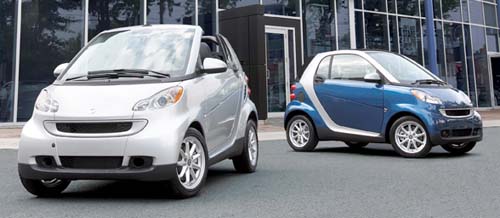2008 Smart Fortwo
Not that long ago – late 2004 – the smart car arrived in Canada as a sort of experiment on the part of its builder, Mercedes-Benz. The subsidiary set up to market the small urban vehicles had surprisingly not done so well, despite European cities being full of the things. So, it was time to see if North American city-dwellers might be talked into the funky little runabouts.
But not Americans, mind you. A few years ago, even the hippest US city dweller wouldn’t be interested in a really small hatchback, a diesel-powered one at that. And diesels would have certification issues there in any case. But times change, gas prices are the highest ever, cities are clogged with traffic, and just maybe the time is right for the smart fortwo. After all, it far exceeded sales expectations in Canada, and a completely new model should be a hit, even in the USA.
So it was no surprise that the first chance we had to drive the new smart was in hip San Francisco and area, and if the reaction of people there was any gauge, the time may be right.
You have to look hard to detect the differences in design on the outside, but the interior is all-new and suitably avant-garde. There is actually quite a bit of room for taller people both fore-and-aft and vertically, although if you and your passenger are broad-shouldered, it will be tight side-to-side. The seats themselves are the most supportive in this price range. Cargo space is as you might expect. A few big shopping bags or soft luggage bags will be about it, but that should be plenty for urban use – unless your golf clubs need to go with you.
The smart is really all-new under the skin, as the 600-cc diesel three with but 40 hp has been replaced with a 999-cc gasoline three (incidentally made by Mitsubishi). There is a slight increase in fuel consumption, although 5.9/4.8 city/hwy is nothing to sneeze at, and it makes the smart the most frugal gas-powered (not hybrid) car available here. The 70 hp of the new engine is well worth a bit more thirst, as it now can keep up with most traffic, even on the highway, up to its 145 km/h top speed.
Acceleration, though, is still a bit leisurely, due again in part to the same sort of automatic-manual transmission as before. Left to its own devices, shifts are only slightly less leisurely than in the last generation, with a noticeable hesitation. The deluxe smart passion models have paddle shifters, and using them to shift manually makes for a far more enjoyable and responsive ride. Handling is nimble, but the smart is no sports car; understeer is prevalent when pushing into a corner.
Models offered are the fortwo pure at $14,990, and the fortwo passion, both as coupe ($18,250) and cabriolet ($21,250). The pure, which we didn’t drive, looks pretty basic according to the specs, although it does have full safety equipment including ABS, electronic stability program and side airbags. It costs about $2,000 less than the previous base version, and one might expect that it will be eligible for the $2,000 federal rebate.
We did drive the passion cabrio, though, which is pretty much loaded, as one might hope for $21K. Alloy wheels, power top, deluxe audio with auxiliary input, a/c, power windows/mirrors/locks….all the fun stuff. The optional metallic red paint and “design red” interior really got the looks.
The smart is a proven success in Canada and that should continue, and now we’ll see if Americans are ready to embrace it. The diesel might have been a bit of a longshot given its leisurely performance, but the new gas engine and interior upgrades should make it as big a hit in New York and San Francisco as it is in Toronto and Vancouver.
Copyright © Auto Reviews Online 2016 | Privacy & Terms of Use | info@autoreviewsonline.com | Website by Brolly Media

